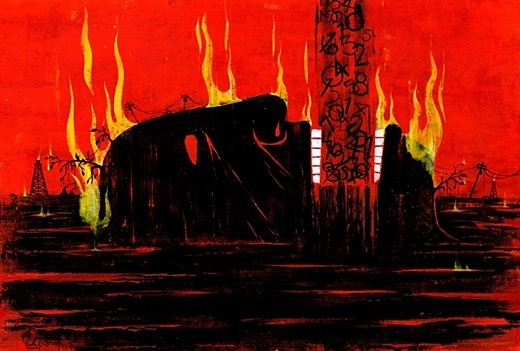By Joe Romm on 23 July 2012 for Think Progress -
(http://thinkprogress.org/climate/2012/07/23/565751/mckibben-must-read-global-warming039s-terrifying-new-math)

Image above: Iluustration for McKibbon Rolling Stone article by Edel Rodrigeuz. From (http://www.rollingstone.com/politics/news/global-warmings-terrifying-new-math-20120719).
Climate hawk Bill McKibben has a terrific new piece in Rolling Stone, “Global Warming’s Terrifying New Math.”
It is getting monster social media numbers of the kind usually reserved for pieces on HuffPost about Kim Kardashian in a bikini: 66k FaceBook likes and an astounding 6300 retweets. That means millions of people have likely been exposed to at least the headline and probably some of the opening text:
If the pictures of those towering wildfires in Colorado haven’t convinced you, or the size of your AC bill this summer, here are some hard numbers about climate change: June broke or tied 3,215 high-temperature records across the United States. That followed the warmest May on record for the Northern Hemisphere – the 327th consecutive month in which the temperature of the entire globe exceeded the 20th-century average, the odds of which occurring by simple chance were 3.7 x 10-99, a number considerably larger than the number of stars in the universe.
Meteorologists reported that this spring was the warmest ever recorded for our nation – in fact, it crushed the old record by so much that it represented the “largest temperature departure from average of any season on record.” The same week, Saudi authorities reported that it had rained in Mecca despite a temperature of 109 degrees, the hottest downpour in the planet’s history.The three key numbers are:
Not that our leaders seemed to notice….
- The First Number: 2° Celsius [3.6° Fahrenheit]: The temperature rise we need to work as hard as possible to limit total warming to if we want to have our best chance of averting multiple catastrophes and amplifying carbon cycle feedbacks.
- The Second Number: 565 Gigatons “Scientists estimate that humans can pour roughly 565 more gigatons of carbon … into the atmosphere by midcentury and still have some reasonable hope of staying below two degrees. (‘Reasonable,’ in this case, means four chances in five, or somewhat worse odds than playing Russian roulette with a six-shooter.)”
- The Third Number: 2,795 Gigatons “This number is the scariest of all – one that, for the first time, meshes the political and scientific dimensions of our dilemma…. The number describes the amount of carbon already contained in the proven coal and oil and gas reserves of the fossil-fuel companies, and the countries (think Venezuela or Kuwait) that act like fossil-fuel companies. In short, it’s the fossil fuel we’re currently planning to burn.
McKibben writes too thoughtfully to summarize — and too eloquently to paraphrase. You should read the whole thing, which ends:
The three numbers I’ve described are daunting – they may define an essentially impossible future. But at least they provide intellectual clarity about the greatest challenge humans have ever faced. We know how much we can burn, and we know who’s planning to burn more. Climate change operates on a geological scale and time frame, but it’s not an impersonal force of nature; the more carefully you do the math, the more thoroughly you realize that this is, at bottom, a moral issue; we have met the enemy and they is Shell.
Meanwhile the tide of numbers continues. The week after the Rio conference limped to its conclusion, Arctic sea ice hit the lowest level ever recorded for that date. Last month, on a single weekend, Tropical Storm Debby dumped more than 20 inches of rain on Florida – the earliest the season’s fourth-named cyclone has ever arrived. At the same time, the largest fire in New Mexico history burned on, and the most destructive fire in Colorado’s annals claimed 346 homes in Colorado Springs – breaking a record set the week before in Fort Collins. This month, scientists issued a new study concluding that global warming has dramatically increased the likelihood of severe heat and drought – days after a heat wave across the Plains and Midwest broke records that had stood since the Dust Bowl, threatening this year’s harvest.
.You want a big number? In the course of this month, a quadrillion kernels of corn need to pollinate across the grain belt, something they can’t do if temperatures remain off the charts. Just like us, our crops are adapted to the Holocene, the 11,000-year period of climatic stability we’re now leaving… in the dust.
No comments :
Post a Comment